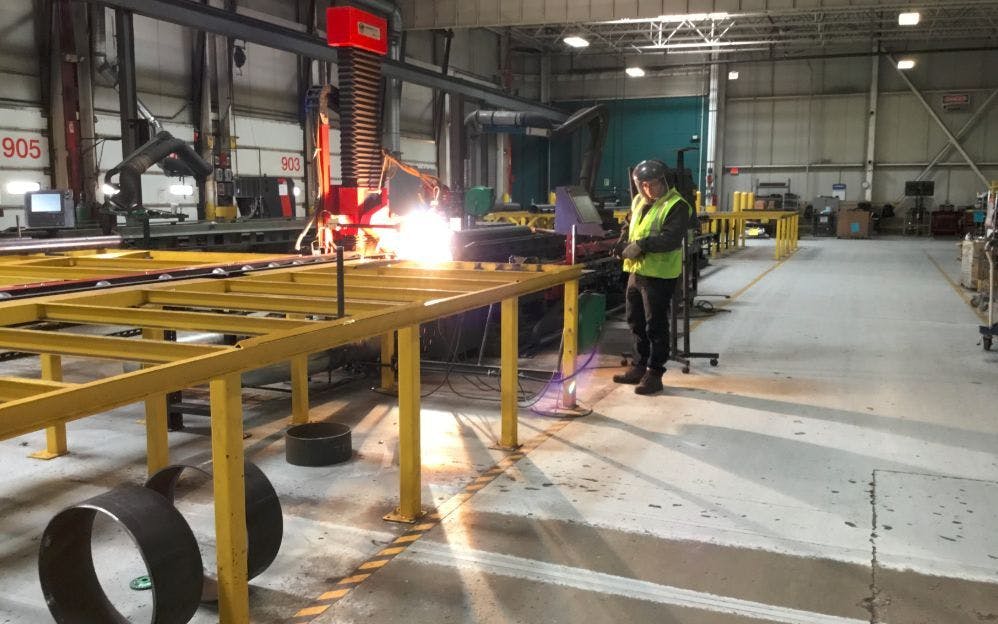
Case Study: Creating Energy Self-Sufficiency in Mechanical Construction Prefabrication
Shapiro & Duncan is a mechanical construction industry leader in prefabricated pipe assemblies. With the upfront investment of intelligence by Shapiro & Duncan’s people in the planning stage, as well as with state-of-the-art technology and equipment, the company’s highly skilled team on the fabrication shop floor fabricates and assembles any type of piping configuration, from a simple riser to piping assemblies for the most complex central mechanical plants.
The systems assembly area has been used for multi-trade skid-mounted assemblies as well as the production of modular multi-trade units. The shop’s controlled environment enables them to maintain the highest level of quality and a constant level of productivity, regardless of weather.
In 2018, their company took on the challenge of making the fabrication shop self-sufficient in its energy supply. What follows is the success story of how Shapiro & Duncan transformed from coal-fired electricity to solar power.
Why Solar?
Since the industrial revolution, factories have been among the world’s biggest consumers of energy due to their mass scale and high volume of processes centralized in one location. As a result of the major energy costs associated with manufacturing, many CEOs (such as Tesla’s Elon Musk) have identified solar power as the perfect way to reduce operating costs.
Much of the excitement around solar energy in the 21st century has been due to its rapid decline in price across the globe. At the end of 2016, solar power became the cheapest energy source in the world, surpassing wind and its fossil fuel counterparts such as natural gas.
When it comes to commercial applications like manufacturing plants, the beauty of solar is that most energy use occurs during the day. Large commercial plants can benefit from solar power without needing to buy a storage solution to cover nighttime energy usage. When a factory’s energy use is at its peak, a solar system will equivalently be at peak production; at night, the facility requires little energy while the solar system is dormant.
Furthermore, larger commercial solar systems are an even better deal in terms of long-term savings because of the economies-of-scale dynamic with solar power. Third-party data providers are in consensus that the cost per watt a consumer will pay for a solar system will decrease as the system size increases. For bigger manufacturing facilities, the break-even point can potentially be just a few years.
Solar also makes sense for manufacturing plants due to the style of roof most commonly associated with large commercial buildings: A large flat roof with plenty of ample roof space can make for easier and faster system installation.
Meeting the Solar Installation Challenge
To meet the fabrication shop’s solar challenge, the Shapiro & Duncan team, which included their solar project development partner Aurora Energy, had the opportunity to maximize its coverage with photovoltaic (PV) solar panels on the 52,000 square feet of roof.
Aurora Energy started by determining the exact kilowatt-hour draw and demand draw, using interval data for the facility. This data established the electrical output required by the solar power system.
On the roof, the team proceeded to install 925 SunPower solar modules, mounted on a Panel Claw support system, along with three SolarEdge power optimizers. The resulting system is rated to produce 302 kilowatts of solar power and almost 400-megawatt hours (Mwh) of energy per year. This is enough solar power output to meet 100% of the prefabrication facility’s energy needs.
The solar panels feed into a SolarEdge dashboard, which is directly connected to the electrical grid at a new dual direction electrical meter. A huge advantage of this metering technology is that it provides a real-time view of the building’s energy consumption load versus actual energy production.
Additional advantages include a 25-year lifetime guaranty and the fact that the initial capital investment will be recouped in less than six years. Over the life of the system, it will save anearly $2 million in energy costs.
In the center hallway of the shop, a wall of big screen monitors shows in detail the assembly production by task and individual tracking progress and effectiveness. One of the monitors shows the solar PV production, so now the whole team can see where they are in producing their assemblies and monitor the electrical production at the same time.
Green Results
The system went live Dec. 28, 2018, and has generated more than 170 Mwhs of energy to date. By switching from coal-fired power to sun power, Shapiro & Duncan has saved more than 275,000 pounds of CO2 emissions—the equivalent of planting more than 7,500 trees.
Not only was this a smart investment of company capital with a tremendous return, but it was also the right thing to do for the planet. The solar-powered prefabrication facility is a shining example of Shapiro & Duncan’s commitment to future investments. The company’s mantra, as it moves forward, is to continue investing in its people, its processes and its plant to ensure that the company is always ready to take the next step.
Related stories








